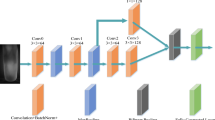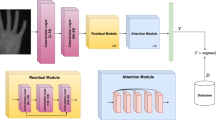Abstract
Finger vein recognition is an advanced biometric recognition technology that offers high precision and high security. It recognizes or authenticates individuals using irradiating vein texture images collected from fingers with near-infrared light. In this paper, we propose a new finger vein recognition model (MMRAN) based on a multiscale and multistage residual attention network. First, to fully adapt to the low-resolution, grayscale pixels, and linear patterns of finger vein images, we designed an architecture that combines a fusion residual attention block (FRAB) and a multistage residual attention connection (MRAC). The FRAB contains two distinct subpaths: the main vein path (MVP) and the guided attention path (GAP). The MVP extracts finger vein features at multiple scales by using a multibranch residual structure, while the GAP uses an hourglass network to generate weight maps to guide the setting of eigenvalues at corresponding locations in the main vein feature map. MRAC integrates venous features extracted at different learning stages through the above two pathways. The proposed multiscale and multistage extraction model is effective at extracting various types of digital vein features, including those whose shapes change in width, direction, curvature, and so on. We combine the various dimensions of vein features through multistage learning to further improve the model performance for extracting high-level abstract features. To evaluate the performance of our proposed model, we conducted a large number of experiments on five publicly available finger vein datasets. The experimental results show that the proposed model not only achieves a recognition accuracy above 98%, which is an improvement compared to the current state-of-the-art methods, but it can also be implemented with fewer parameters, which improves training and inference.












Similar content being viewed by others
Explore related subjects
Discover the latest articles, news and stories from top researchers in related subjects.References
Kono M (2000) A new method for the identification of individuals by using of vein pattern matching of a finger. In: Proc. Fifth Symposium on Pattern Measurement, Yamaguchi, Japan, 2000, pp 9–12
Kono M, Ueki H, Umemura S (2002) Near-infrared finger vein patterns for personal identification. Appl Opt 41(35):7429–7436
Miura N, Nagasaka A, Miyatake T (2004) Feature extraction of finger-vein patterns based on repeated line tracking and its application to personal identification. Mach Vis Appl 15(4):194–203
Miura N, Nagasaka A, Miyatake T (2007) Extraction of finger-vein patterns using maximum curvature points in image profiles. IEICE T Inf Syst 90(8):1185–1194
Radzi S A, Hani M K, Bakhteri R (2016) Finger-vein biometric identification using convolutional neural network. Turk J Elec Eng Comp Sci 24(3):1863–1878
Liu W, Li W, Sun L, Zhang L, Chen P (2017) Finger vein recognition based on deep learning. In: 2017 12th IEEE conference on industrial electronics and applications (ICIEA). IEEE, pp 205– 210
Das R, Piciucco E, Maiorana E, Campisi P (2018) Convolutional neural network for finger-vein-based biometric identification. IEEE T Inf Foren Sec 14(2):360–373
Qin H, El-Yacoubi M A (2019) Finger-vein quality assessment based on deep features from grayscale and binary images. Int J Pattern Recogn 33(11):1940022
Ren H, Sun L, Guo J, Han C, Cao Y (2022) A high compatibility finger vein image quality assessment system based on deep learning. Expert Syst Appl 196(1):116603
Yang L, Yang G, Yin Y, Xiao R (2013) Sliding window-based region of interest extraction for finger vein images. Sensors 13(3):3799–3815
Qiu S, Liu Y, Zhou Y, Huang J, Nie Y (2016) Finger-vein recognition based on dual-sliding window localization and pseudo-elliptical transformer. Expert Syst Appl 64:618–632
Bilal A, Sun G, Mazhar S (2021) Finger-vein recognition using a novel enhancement method with convolutional neural network. J Chin Inst Eng 44(5):407–417
Bros V, Kotwal K, Marcel S (2021) Vein enhancement with deep auto-encoders to improve finger vein recognition. In: Proceedings of: International Conference of the Biometrics Special Interest Group, pp 1–5
Meng X, Zheng J, Xi X, Zhang Q, Yin Y (2021) Finger vein recognition based on zone-based minutia matching. Neurocomputing 423:110–123
Ma H, Hu N, Fang C (2021) The biometric recognition system based on near-infrared finger vein image. Infrared Phys Techn 116:103734
Wang K, Chen G, Hongjia C (2021) Finger vein recognition based on multi-receptive field bilinear convolutional neural network. IEEE Signal Proc Let 28(1):1590–1594
Bahdanau D, Cho K, Bengio Y (2015) Neural machine translation by jointly learning to align and translate. In: Proceedings of the International conference on learning representations, pp 1–15
Woo S, Park J, Lee J-Y, Kweon I S (2018) Cbam: Convolutional block attention module. In: Proceedings of the European conference on computer vision, pp 3–19
Hu J, Shen L, Sun G (2018) Squeeze-and-excitation networks. In: Proceedings of the IEEE conference on computer vision and pattern recognition, pp 7132–7141
Wang Q, Wu B, Zhu P, Li P, Zuo W, Hu Q (2020) Eca-net: Efficient channel attention for deep convolutional neural networks. In: Proceedings of the IEEE conference on computer vision and pattern recognition, pp 11531–11539
Jiang G, Jiang X, Fang Z, Chen S (2021) An efficient attention module for 3d convolutional neural networks in action recognition. Appl Intell 5(1):7043–7057
Wang F, Jiang M, Qian C, Yang S, Li C, Zhang H, Wang X, Tang X (2017) Residual attention network for image classification. In: Proceedings of the IEEE conference on computer vision and pattern recognition, pp 3156–3164
He K, Zhang X, Ren S, Sun J (2016) Deep residual learning for image recognition. In: Proceedings of the IEEE conference on computer vision and pattern recognition, pp 770–778
Ioffe S, Szegedy C (2015) Batch normalization: Accelerating deep network training by reducing internal covariate shift. In: International conference on machine learning. PMLR, pp 448– 456
Newell A, Yang K, Deng J (2016) Stacked hourglass networks for human pose estimation. In: European conference on computer vision. Springer, pp 483–499
Yin Y, Liu L, Sun X (2011) Sdumla-hmt: a multimodal biometric database. In: Chinese Conference on Biometric Recognition. Springer, pp 260–268
Asaari M S M, Suandi S A, Rosdi B A (2014) Fusion of band limited phase only correlation and width centroid contour distance for finger based biometrics. Expert Syst Appl 41(7):3367–3382
Lu Y, Xie S J, Yoon S, Wang Z, Park D S (2013) An available database for the research of finger vein recognition. In: 2013 6th International congress on image and signal processing (CISP), vol 1. IEEE, pp 410–415
Ton B T, Veldhuis RNJ (2013) A high quality finger vascular pattern dataset collected using a custom designed capturing device. In: 2013 International conference on biometrics (ICB). IEEE, pp 1–5
Ren H, Sun L, Guo J, Han C, Wu F (2021) Finger vein recognition system with template protection based on convolutional neural network. Knowl-Based Syst 227:107159
Dosovitskiy A, Beyer L, Kolesnikov A, Weissenborn D, Zhai X, Unterthiner T, Dehghani M, Minderer M, Heigold G, Gelly S et al (2021) An image is worth 16x16 words: Transformers for image recognition at scale. In: Proceedings of the International conference on learning representations, pp 1–22
Howard A, Sandler M, Chu G, Chen L-C, Chen B, Tan M, Wang W, Zhu Y, Pang R, Vasudevan V et al (2019) Searching for mobilenetv3. In: Proceedings of the IEEE international conference on computer vision, pp 1314–1324
Ma N, Zhang X, Zheng H-T, Sun J (2018) Shufflenet v2: Practical guidelines for efficient cnn architecture design. In: Proceedings of the European conference on computer vision, pp 116–131
Han K, Wang Y, Tian Q, Guo J, Chunjing X, Chang X (2020) Ghostnet: More features from cheap operations. In: Proceedings of the IEEE conference on computer vision and pattern recognition, pp 1580–1589
Yang L, Yang G, Yin Y, Xi X (2017) Finger vein recognition with anatomy structure analysis. IEEE T Circ Syst Vid 28(8):1892–1905
Lu Y, Yoon S, Wu S, Park D S (2018) Pyramid histogram of double competitive pattern for finger vein recognition. IEEE Access 6:56445–56456
Meng X, Xi X, Yang G, Yin Y (2018) Finger vein recognition based on deformation information. Sci China Inf Sci 61(5):1–15
Liu H, Yang G, Yang L, Yin Y (2019) Learning personalized binary codes for finger vein recognition. Neurocomputing 365:62–70
Kang W, Lu Y, Li D, Jia W (2018) From noise to feature: Exploiting intensity distribution as a novel soft biometric trait for finger vein recognition. IEEE T Inf Foren Sec 14(4):858–869
Liu H, Yang G, Yang L, Su K, Yin Y (2019) Anchor-based manifold binary pattern for finger vein recognition. Sci China Inf Sci 62(5):1–16
Kang W, Liu H, Luo W, Deng F (2019) Study of a full-view 3d finger vein verification technique. IEEE T Inf Foren Sec 15:1175–1189
Zhang L, Li W, Ning X, Sun L, Dong X (2021) A local descriptor with physiological characteristic for finger vein recognition. In: 2020 25th International Conference on Pattern Recognition (ICPR). IEEE, pp 4873–4878
Yao Q, Song D, Xu X, Zou K (2021) A novel finger vein recognition method based on aggregation of radon-like features. Sensors 21(5):1885
Acknowledgements
This research is supported by the Key R & D Project of Jilin Provincial Science and Technology Development Plan (No. 20200401103GX), Jilin Provincial Industrial Technology R & D Project (No. 2021c045-9), Key R & D Project of Jilin Provincial Science and Technology Development Plan (No. 20210202129nc), and the National Natural Science Foundation of China (No. 61806024).
Author information
Authors and Affiliations
Corresponding authors
Ethics declarations
Conflict of Interests
There is no conflict of interest.
Additional information
Publisher’s note
Springer Nature remains neutral with regard to jurisdictional claims in published maps and institutional affiliations.
Rights and permissions
About this article
Cite this article
Liu, W., Lu, H., Wang, Y. et al. MMRAN: A novel model for finger vein recognition based on a residual attention mechanism. Appl Intell 53, 3273–3290 (2023). https://doi.org/10.1007/s10489-022-03645-7
Accepted:
Published:
Issue Date:
DOI: https://doi.org/10.1007/s10489-022-03645-7




